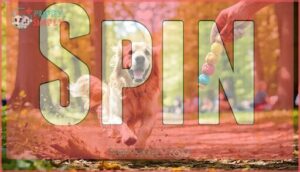This site is supported by our readers. We may earn a commission, at no cost to you, if you purchase through links.

You’ll need treats, patience, and five-minute training sessions to keep things fun. Begin with "shake" by lifting your dog’s paw while saying the command, then reward immediately. "Spin" works by luring with treats in a circle motion.
These simple tricks boost your dog’s confidence while strengthening your bond through positive reinforcement. The secret sauce isn’t complex commands or fancy equipment – it’s consistency and timing your rewards perfectly to create those "aha!" moments that reveal your dog’s hidden potential.
Table Of Contents
- Key Takeaways
- Benefits of Trick Training
- Nose Bump
- Chill
- Ring a Bell to Go Potty
- Shake Paws
- Leg Weave
- Say Hi!
- Spin
- Advanced Tricks
- Frequently Asked Questions (FAQs)
- What is the easiest trick to teach your dog?
- What is the easiest dog to teach?
- What is the easiest command to teach a dog?
- What is the 1 2 3 dog training method?
- What are the best rewards for teaching my dog tricks?
- How do I know when my dog has learned a trick?
- Are there any safety precautions I should take when teaching my dog tricks?
- How long should I spend teaching my dog tricks?
- What age is the best to start teaching my dog tricks?
- How long should each training session last?
- Conclusion
Key Takeaways
- Start with foundational tricks like "sit," "shake," and "spin" since they’re quick wins that build your dog’s confidence and create momentum for more advanced training.
- Keep training sessions short at 5-10 minutes to match your dog’s attention span, using high-value treats and immediate rewards to maximize learning without causing frustration.
- Master the basics before advancing – your dog needs to know "sit" and "down" commands before tackling impressive tricks like "roll over" or "take a bow."
- Focus on consistency and timing rather than perfection, as regular practice with positive reinforcement strengthens your bond while revealing your dog’s hidden potential.
Benefits of Trick Training
Teaching your dog easy dog tricks offers incredible benefits beyond simple entertainment.
Transform playtime into powerful bonding moments that boost your dog’s confidence and intelligence.
Beginner dog tricks provide essential mental stimulation, keeping your pup’s mind sharp and engaged.
Dog trick training strengthens the bonding between you and your furry friend through positive interactions and shared accomplishments.
These activities also boost your dog’s confidence as they master new skills.
You’ll notice behavioral improvements as training reinforces good habits and focus.
Plus, trick sessions offer light physical exercise while building communication skills that enhance your relationship.
Nose Bump
Building on trick training’s mental benefits, the nose bump teaches your dog precise hand targeting. This simple trick forms the foundation for more complex nose work and enhances focus enhancement while building impulse control.
Hold your palm flat in front of your dog’s face. When they naturally sniff or bump your hand with their nose, immediately say "touch" and reward them. Practice this basic target training daily until they consistently bump your palm on command.
Here’s what makes nose bump one of the best easy dog tricks for beginners:
- Your dog learns to focus on your hand signals instead of distractions
- It builds the foundation for advanced beginner dog tricks like door closing
- The trick requires no props or special equipment
Once mastered, you can teach dog tricks like turning on light switches or pressing elevator buttons using this same targeting technique.
Chill
Chill" teaches your dog to stay calm and relaxed, making it perfect for anxious dogs who need better impulse control.
This trick combines basic dog tricks with calming techniques that create a quiet environment for learning.
Start with your pup in a down position, then practice relaxation training by rewarding stillness even with distractions nearby.
Use mental stimulation through short training sessions, gradually increasing difficulty, which helps teach dog tricks while building confidence.
With consistent practice, this becomes one of the most useful easy dog tricks for beginners to master, especially for teaching calming techniques and basic dog commands.
Ring a Bell to Go Potty
Your dog’s bathroom communication just got an upgrade with bell training basics. Place a bell near your most-used door and teach your pup to ring it using the "touch" command.
Start by holding treats near the bell, rewarding nose bumps. This potty cue association develops quickly with consistent practice.
Bell placement options include hanging bells or floor buttons. Many owners find success using a quality dog bell for this training.
Most dogs master this easy dog trick within two weeks of short training sessions. Troubleshooting ringing issues usually involves more consistent rewards and patience during puppy training tricks.
Shake Paws
Once you’ve mastered bell training, it’s time for some paw-some fun! Shake paws ranks among the most beloved dog tricks for beginners, teaching proper paw etiquette while strengthening your bond.
Here’s your step-by-step approach:
- Start with sit – Your pup should master this basic command first
- Use hand targeting – Hold a treat in your closed fist near their paw
- Apply positive reinforcement – Say "shake" when they lift their paw naturally
- Practice trick variations – Try high-fives or gentle paw holds
Monitor paw health during training sessions, keeping practice short and rewarding.
Leg Weave
After your dog’s got shake paws down pat, leg weaves make an impressive next step.
This trick builds body awareness and spatial awareness as your pup navigates between your legs in a figure-eight pattern.
Start with treats to guide them through, focusing on leg coordination and building human-dog trust. A convenient treat carrier can help with this training.
These easy dog tricks for beginners strengthen your bond while providing excellent weave training practice.
Say Hi!
Teaching your dog "Say Hi!" creates the perfect foundation for greeting etiquette and positive interactions.
This simple command combines hand targeting with socialization skills, making it one of the most practical easy dog tricks for beginners.
Here’s how to master this fun dog trick:
- Start with your dog in a sitting position
- Hold your hand up like you’re waving
- Say "Say Hi!" and wait for paw movement
- Reward immediately when they lift their paw
- Practice daily with short, positive training sessions
This easy trick teaches proper paw targeting while building confidence.
Spin
Ready to add some pizzazz to your dog’s repertoire? The spin trick transforms your pup into a four-legged dancer with just a few simple steps.
Start with your dog in a standing position. Hold a high-value treat close to their nose, then slowly move it in a circular motion around their head. As they follow the treat, they’ll naturally turn their body.
Once they complete a full circle, immediately say "spin" and reward them. This lure technique works best when you keep the treat at nose level.
Teaching directions matter – pick clockwise or counterclockwise and stick with it. Common mistakes include moving the treat too fast or holding it too high. Consider your dog’s physical limitations before starting.
With patience, this fun dog trick becomes one of the easiest dog tricks for beginners to master through consistent dog training for beginners sessions.
Advanced Tricks
Once your dog masters the basics, you’re ready to teach more impressive tricks that’ll wow your friends and family.
These advanced commands require patience and practice, but they’ll strengthen your bond while giving your pup a fun mental workout, helping to create a more fulfilling relationship through impressive tricks.
Army Crawl
After your pup has mastered spinning in circles, it’s time to get them low and slow with the Army Crawl. This impressive trick builds core strength and body awareness while looking incredibly cool.
The Army crawl requires your dog to stay flat on their belly and pull themselves forward using only their front paws. It’s like watching a four-legged commando in action! This low crawl technique challenges your pup’s physical coordination and mental focus.
Here’s how to teach this beginner-friendly trick:
- Start with your dog in the down position
- Hold a treat close to their nose, keeping it low
- Slowly move the treat forward along the ground
- Reward any forward movement while staying down
- Gradually increase the crawling distance
Crawl prerequisites include knowing basic "down" and "stay" commands. This easy trick to teach becomes one of those impressive dog tricks for beginners that’ll have everyone asking, "How’d you do that?" With consistent practice, your pup will master these army crawl variations in no time. Consider specialized training equipment to enhance your dog’s army crawl performance.
Back-up
After your dog masters crawling, it’s time to work on the back up command.
This simple dog command builds spatial awareness and body awareness while teaching controlled retreat.
Start by facing your dog and gently step toward them. When they take a step backward, immediately reward with a treat and praise.
Gradually increase the backward movement distance as they improve. Use a verbal cue like "back up" paired with a hand signal.
This easy dog trick helps with obstacle avoidance in crowded spaces and strengthens your pup’s confidence. Practice daily sessions for best results in dog training for beginners.
Jump Through a Hoop
Once your pup masters backing up, it’s time to amp up the fun with jump training! This circus-worthy trick combines athleticism with showmanship.
Start by placing the hoop’s bottom edge on the ground, creating an easy walkthrough. Guide your dog inside with treats, then encourage forward movement until they step through completely.
Here’s your jump progression roadmap:
- Hoop Size: Begin with larger hoops for confidence-building
- Jump Height: Gradually raise from ground level to knee-high
- Target Training: Use treats to guide movement direction
- Safety First: Always check for proper landing space.
Practice daily for impressive results!
Roll-over
One of the most impressive easy dog tricks for beginners is the classic roll over command. This prerequisite commands foundation starts with your dog knowing "down" perfectly.
Begin by teaching a settled down position where your pup’s back legs are kicked out and they’re resting on one hip, not the sphinx-style square down. Here’s the rolling technique: Ask your dog to lie down, then bring a treat from their front toward their rib cage.
As their body starts to lean, reward immediately with positive reinforcement. Gradually increase the turning amount before giving the reward. Once they’re rolling completely over, remove the treat lure.
Common mistakes include rushing the process or skipping the settled down step. Training duration varies, but most dogs master this within several weeks. Safety considerations include ensuring adequate space and soft surfaces.
These dog training tips help create a fun bonding experience while building your pup’s confidence and skills.
Close The Door
Teaching your pup to close the door combines practicality with impressive showmanship. This advanced trick helps when you’re carrying groceries or relaxing with coffee.
Start with door closing basics using nose targeting, then progress through our step-by-step guide:
- Hold target against open door at nose height
- Reward when dog touches target with nose
- Add "close the door" command during practice
- Remove target once dog responds to verbal cue
- Celebrate when door shuts completely
Safety considerations include ensuring proper door weight and smooth hinges. Troubleshooting tips involve patience if your dog seems hesitant – some prefer paw pushing over nose bumping.
This dog training technique takes consistent practice, but automating the trick creates a useful household helper. These easy dog tricks strengthen your bond while providing mental stimulation.
Give a Hug
Heart-melting moments await when your furry friend learns this adorable affection display. The hug trick transforms basic commands into intimate bonding experiences.
Before starting these dog trick instructions, make certain your pup masters sit and paw commands as hug prerequisites. Start by kneeling beside your dog, then gently guide their front paws onto your shoulders.
Use the verbal cue "hug" while positioning their paws around your neck. Reward immediately when they maintain the position. Practice this easy trick to teach in short sessions, as some dogs feel uncomfortable with prolonged contact.
Consider breed suitability—smaller dogs adapt quicker than larger breeds. Address safety concerns by avoiding force or restraint. This dog training for hugs strengthens your bond while showcasing impressive dog tricks for beginners.
Take a Bow
Imagine this: your furry friend gracefully lowering into a theatrical bow, front legs stretched forward while their rear stays up.
Teaching "take a bow" ranks among the most elegant dog tricks for beginners, perfect for wrapping up any trick performance.
Start with your dog standing.
Hold a treat near their nose, then slowly move it straight down to the floor between their front paws.
As they follow the treat, their elbows will naturally touch the ground.
The moment they achieve this position, say "yes" and reward them immediately.
Keep them moving so they don’t lie down completely.
Practice this easy trick in short five-minute sessions.
Once they understand the movement, add the cue word "bow" before using your hand signal.
This photographic pose works for all breed suitability levels, though consider any physical limitations your dog might have.
With consistent dog training, your pup will master bow variations and perfect bow duration timing.
Ring a Bell
Ring a bell tricks showcase your dog’s intelligence while creating impressive entertainment for guests.
Bell Training Basics start with choosing the right location – place your bell near the door you use most for potty breaks.
Different Bell Types include traditional bells, electronic buttons, or chimes that suit your dog’s size and preferences.
Hold the bell close to your pup’s nose and say "touch." When they bump it with their nose, reward immediately with treats and praise.
Bell Placement Tips suggest keeping it at your dog’s nose level for easy access.
This beginner pet trick builds communication skills while adding flair to your dog trick guide repertoire, and is a great way to improve your dog’s intelligence and train them to use a bell.
Figure 8
The Figure 8 trick transforms your dog into a canine choreographer, weaving gracefully around your legs like a furry dance partner.
This beginner pet trick looks impressive but breaks down into simple steps that’ll have your pup mastering the figure of 8 in no time.
Start your Figure 8 Setup by standing with feet shoulder-width apart.
Hold treats in both hands for effective Luring Techniques—guide your dog around your left leg, then your right, creating the classic pattern.
Use gentle Leash Guidance initially if your dog gets distracted or confused.
Practice Spaces should be clear of obstacles, giving your pup room to move freely.
Common Troubleshooting Tips include keeping sessions short and rewarding each successful loop.
This easy tricks to teach method builds coordination while strengthening your bond.
With patience, your dog trick guide success story unfolds beautifully.
Hold an Object
Teaching your dog to hold an object builds impressive grip strength and focus. This beginner pet trick requires patience but creates amazing results when your pup masters duration training.
Here’s your step-by-step approach:
- Object Selection – Start with a favorite chew toy your dog already enjoys
- Initial Contact – Reward immediately when they touch the item with their mouth
- Grip Development – Gradually increase holding time before treating
- Dropping Prevention – Use "hold" command consistently until they release on cue
Agility Weave Poles
Moving from teaching your dog to hold objects, weaving poles takes your pup’s skills to the next level. This classic agility training exercise builds coordination, focus, and confidence while keeping your furry friend mentally engaged.
Start with a simple Weave Pole Setup using just three poles spaced about 20 inches apart. Your dog needs to understand Entry and Exit points before mastering the full sequence. Begin by walking your dog through the pattern on leash, rewarding each correct movement.
Training Progression works best when you break it down into small steps:
- Guide your dog through with treats – Use high-value rewards to lure them between poles
- Practice the weaving motion slowly – Speed comes after accuracy
- Gradually increase pole count – Add more poles as confidence builds
Common Mistakes include rushing the process and spacing poles too close together. Problem Solving often means going back to basics when your dog gets confused. Remember, this fun dog trick requires patience, but the results make it one of the most rewarding easy tricks for dogs to master.
Crawl
The crawl trick transforms your dog into a four-legged commando! Start your Crawl Setup by having your pup lie down completely.
Use Luring Techniques with treats held close to the ground, moving slowly forward. Keep initial Crawl Duration short—just a few inches counts as success.
Crawl Challenges include dogs wanting to stand up, so practice patience. Try Crawl Variations like army crawling under furniture.
This beginner pet trick builds core strength while impressing friends with your dog training skills!
Back–Up
With patience and treats, you’ll teach your dog backward movement like a pro.
Start in an open space, holding a treat close to their nose. Step toward them slowly, saying "back up" as they naturally retreat.
Reward each backward step immediately. This simple dog command builds spatial awareness and confidence while teaching controlled retreat—perfect for beginners mastering easy tricks.
Play Dead
Nothing beats the showstopper appeal of "play dead" when you’re looking for impressive dog tricks to wow your friends.
Teaching Bang! starts with your dog already knowing how to roll over—this trick builds naturally from that foundation. Hold a treat near your pup’s nose, then slowly guide them down to their side while saying "bang" or "play dead."
Safety Considerations include practicing on soft surfaces and never forcing your dog into uncomfortable positions. Common Mistakes involve rushing the process—break it into small steps and reward each one. Your dog should lie completely still with legs relaxed.
Advanced Variations include adding dramatic flair with props or teaching them to respond to finger guns. These easy tricks to teach become perfect Photographic Poses that’ll make your social media pop with personality.
Professional Dog Tricks in Dog Shows
Professional dog shows represent the pinnacle of dog performance, where your pup’s tricks face rigorous Judging Criteria and Show Regulations.
Training Intensity reaches new heights as you prepare for complex routines that showcase Trick Difficulty levels beyond basic commands.
Your dog training for advanced tricks must demonstrate precision timing, flawless execution, and impressive Audience Appeal.
Judges evaluate everything from technical skill to showmanship during dog training demonstrations.
These competitions push both you and your dog to master dog tricks that require months of dedicated dog training tricks practice, transforming simple commands into breathtaking performances.
Frequently Asked Questions (FAQs)
What is the easiest trick to teach your dog?
The "sit" command is hands down the easiest trick to teach your dog.
Most pups pick it up within minutes using treats and gentle guidance, making it the perfect starting point for all future training adventures.
What is the easiest dog to teach?
Like finding the perfect dance partner, certain breeds make training feel effortless.
Golden Retrievers, Labrador Retrievers, and Border Collies top the list.
They’re keen to please, highly intelligent, and naturally motivated by treats and praise, which makes them highly trainable.
What is the easiest command to teach a dog?
The "sit" command is hands down the easiest to teach your dog.
Most pups pick it up within minutes using treats and gentle guidance.
It’s your gateway to all other training success.
What is the 1 2 3 dog training method?
Think of training as hitting the target in one shot.
The 1-2-3 method means you give one clear command, wait two seconds for response, then reward three times with treats, praise, and affection when your dog complies.
What are the best rewards for teaching my dog tricks?
High-value treats work best—think small pieces of chicken, cheese, or special training treats.
You can also use praise, toys, or playtime.
Match the reward to what motivates your dog most for faster learning.
How do I know when my dog has learned a trick?
When your dog’s lightbulb moment arrives, you’ll see consistent responses without treats or prompts. They’ll perform the trick reliably across different locations and situations, showing they’ve truly mastered the behavior.
Are there any safety precautions I should take when teaching my dog tricks?
Always train in a safe, open space away from hazards.
Don’t force uncomfortable positions or use harsh corrections.
Watch for signs of stress or fatigue. Stop sessions if your dog seems overwhelmed or injured.
How long should I spend teaching my dog tricks?
Ironically, rushing through trick training defeats the purpose entirely.
Keep sessions short—just 5-10 minutes daily.
Your dog’s attention span isn’t marathon-length, so quick, frequent practice sessions work better than exhausting hour-long attempts.
What age is the best to start teaching my dog tricks?
You can start teaching tricks at any age – puppies as young as 8 weeks learn quickly, while older dogs bring focus and attention.
There’s no magic window; consistency and patience matter more than timing.
How long should each training session last?
Like a child’s attention span, your pup’s focus fades quickly.
Keep training sessions short—just 5 to 10 minutes each.
This prevents frustration and boredom while maximizing learning.
Multiple brief sessions throughout the day work better than one long one, as this approach helps in maximizing learning.
Conclusion
Like planting seeds that bloom into beautiful flowers, teaching easy dog tricks for beginners transforms simple moments into lasting memories with your furry friend.
You’ve discovered that patience and consistency reveal your dog’s amazing potential through these fifteen commands.
Each trick you’ve mastered together strengthens your bond while building your pup’s confidence. Remember, the journey matters more than perfection.
Keep practicing these easy dog tricks for beginners, celebrate small victories, and watch your dog’s personality shine through every wag and wiggle.












